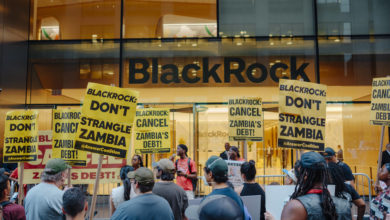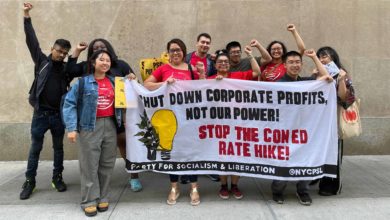Photo: Protesters march through New York City demanding justice for Jordan Neely. Credit: Amanda Yee.
Today, Daniel Penny was finally taken into custody over the killing of New York City street performer Jordan Neely. The day before, after ten days of sustained public pressure, Penny was charged with second-degree manslaughter. Neely, a homeless Black man, was killed by white vigilante violence at the hands of Penny — that much is clear. But just as guilty for his murder is the capitalist system itself — the very system that assigns so many Black and Brown workers to the status of “surplus populations” of the permanently unemployed, subjected to a cycle between the system of mass incarceration and the condition of homelessness. For those suffering from this extreme oppression by capitalism, the system offers two options: prison or homelessness.
Much has been made of Neely’s mental health. We know now that he suffered from depression and schizophrenia, that his mother was murdered in 2007 — an event which marked the beginning of a mental health spiral from which he would never fully recover — and that he was on the the city’s Department of Homeless Services’ list of at-risk people with acute needs. And while it is true that Mayor Eric Adams has drastically gutted social and mental health services since taking office in 2022, the disproportionate focus on Neely’s struggles with mental illness obscures what he needed first and foremost and was deprived of by capitalism: housing.
Housing is the solution to homelessness
The solution to the crisis of homelessness is simple: provide housing. That’s because the number one cause of homelessness is insufficient income and lack of affordable housing — not substance abuse or mental illness, as popularly believed. For women in particular, domestic violence represents the top cause. This is why the cities with the highest housing and rental costs — such as New York City, Boston, Los Angeles, San Francisco, San Diego, and San Jose — also experience the highest rates of homelessness.
Homelessness rapidly degrades your physical and emotional well-being, so it’s no surprise that drug abuse and mental illness often accompany the experience of being unhoused. These two factors, however, are not leading causes in triggering homelessness. West Virginia and Arkansas have some of the highest rates of opioid addiction in the country, yet they have the lowest rates of homelessness. The reason for this is the low cost of housing in both states.
As Gregg Colburn, author of Homelessness Is a Housing Problem, has stated, “I firmly believe that we can’t treat our way out of this problem. You could fix all the addiction in San Diego right now and you’d still have a problem with homelessness because there just aren’t places for people to go who have lower levels of income.”
This popular understanding we have developed of homelessness as caused by drug abuse and mental illness is deliberate. It obscures the social and political forces which drive homelessness, instead placing blame on the individual for their own conditions. This narrative conveniently shifts blame from the system which produces homelessness in the first place: capitalism.
In fact, when asked about Neely’s murder immediately after it occurred, New York state Governor Kathy Hochul responded, “People who are homeless in our subways, many of them in the throes of mental health episodes, and that’s what I believe were some of the factors involved here. There’s consequences for behavior.”
Homelessness, then, becomes a question of individual responsibility and moral character, allowing the state to absolve itself of providing for its own citizens. In New York City, where Neely was murdered, Mayor Eric Adams, has responded to the homelessness crisis through an aggressive campaign of preserving “public safety.” Adams’ Subway Safety Plan flooded the MTA with even more NYPD officers, who patrol stations and trains to arrest the unhoused for simply existing in public. This has also been accompanied by a sophisticated “crime wave” media campaign fearmongering over the unhoused as perpetrators of “transit crime” — even though, statistically, the homeless are much more likely to be victims of violent attacks than assailants.
As we saw with Hochul’s response to Neely’s killing, when the unhoused are presented as inherently dangerous, whatever violence inflicted upon them — whether by police or white vigilantes — is always justified for the sake of public safety. And when homelessness and mental illness is presented as a crisis of individual responsibility, the homeless have no one to blame but themselves for attacks against them.
Capitalism is the crisis
Capitalism cannot solve the housing crisis — the coercive forces of capital will simply not allow it. An economic system driven by the profit motive will treat even the most fundamental of needs such as housing and shelter as a commodity, and seek to maximize that profit at all costs. As just one example, in New York City, landlords are currently withholding over 60,000 rent-stabilized apartments to create an artificial scarcity in order to jack up rental prices in an already increasingly unaffordable city. Renters in New York City cannot rely on Mayor Adams to legislate in their interests, since he has accepted hundreds of thousands of dollars in donations from developers, lobbyists, and the real estate industry over the years.
And since the Great Recession, Wall Street has been buying up apartment buildings and family homes, directly contributing to the crisis in lack of affordable housing. This practice began in the midst of the subprime mortgage crisis that broke out in 2008, when private equity investors — with government bailout funds — took the opportunity to snatch up cheap foreclosed single family houses, especially in areas where housing prices crashed.
Ever since, these Wall Street-backed housing firms have become a major force in the housing market, even purchasing entire neighborhoods. These firms have several major advantages over the average homebuyer. They use algorithms to determine which homes are the best investment, receive lower interest rates, and often buy in cash and have the financial backing to outbid a regular homebuyer. In 2021, one in seven homes were bought by housing corporations backed by private equity investors like Blackrock or investment managers like Pretium Partners.
Experts predict that institutional investors may control 40% of all single-family homes in the United States by 2030. In metropolitan areas like New York City, these corporate landlords buy up apartment buildings, evict longtime tenants, and jack up the rent. These firms also disproportionately target Black neighborhoods. In 2021, 30% of homes sold in majority Black neighborhoods were sold to institutional investors.
Jordan Neely was one of over half a million people who experience homelessness in the United States. While it is true that he needed mental health treatment, he needed housing above all. Without the security and stability that housing provides, any kind of treatment would have been bound to fail. But we cannot rely on a system which produces homelessness in the first place — a system which distributes housing for the sake of private capital accumulation — to also provide a solution to it.
The only solution is to organize a mass movement for an economic system which recognizes housing as the basic right and social good that it is. The only solution is to fight for socialism.






